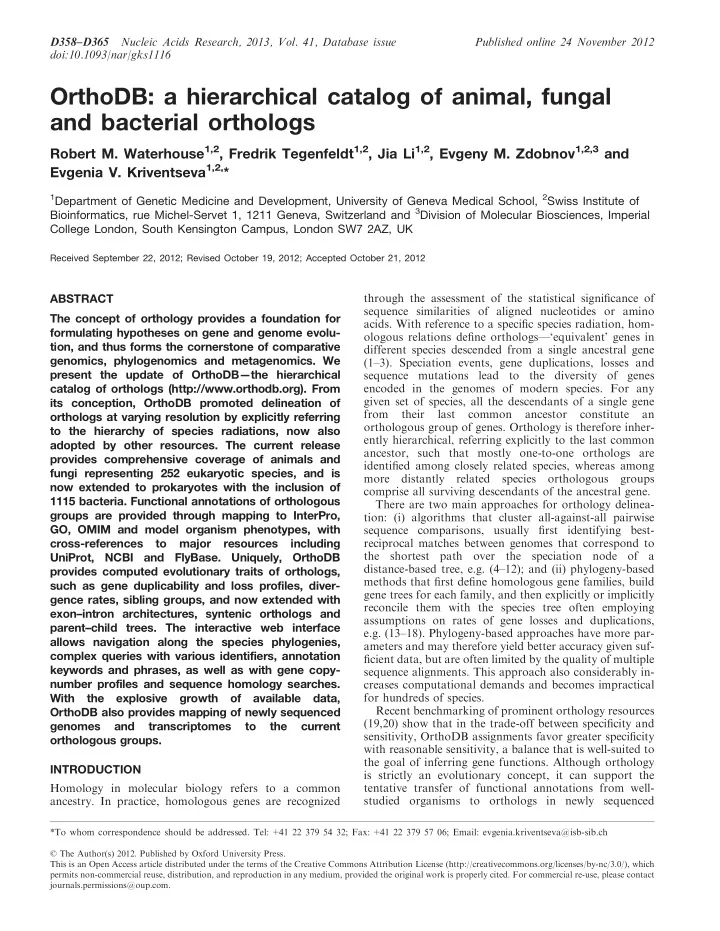

D358–D365 Nucleic Acids Research, 2013, Vol. 41, Database issue Published online 24 November 2012 doi:10.1093/nar/gks1116 OrthoDB: a hierarchical catalog of animal, fungal and bacterial orthologs Robert M. Waterhouse 1,2 , Fredrik Tegenfeldt 1,2 , Jia Li 1,2 , Evgeny M. Zdobnov 1,2,3 and Evgenia V. Kriventseva 1,2, * 1 Department of Genetic Medicine and Development, University of Geneva Medical School, 2 Swiss Institute of Bioinformatics, rue Michel-Servet 1, 1211 Geneva, Switzerland and 3 Division of Molecular Biosciences, Imperial College London, South Kensington Campus, London SW7 2AZ, UK Received September 22, 2012; Revised October 19, 2012; Accepted October 21, 2012 through the assessment of the statistical significance of ABSTRACT sequence similarities of aligned nucleotides or amino The concept of orthology provides a foundation for acids. With reference to a specific species radiation, hom- formulating hypotheses on gene and genome evolu- ologous relations define orthologs—‘equivalent’ genes in tion, and thus forms the cornerstone of comparative different species descended from a single ancestral gene genomics, phylogenomics and metagenomics. We (1–3). Speciation events, gene duplications, losses and present the update of OrthoDB—the hierarchical sequence mutations lead to the diversity of genes catalog of orthologs (http://www.orthodb.org). From encoded in the genomes of modern species. For any given set of species, all the descendants of a single gene its conception, OrthoDB promoted delineation of from their last common ancestor constitute an orthologs at varying resolution by explicitly referring orthologous group of genes. Orthology is therefore inher- to the hierarchy of species radiations, now also ently hierarchical, referring explicitly to the last common adopted by other resources. The current release ancestor, such that mostly one-to-one orthologs are provides comprehensive coverage of animals and identified among closely related species, whereas among fungi representing 252 eukaryotic species, and is more distantly related species orthologous groups now extended to prokaryotes with the inclusion of comprise all surviving descendants of the ancestral gene. 1115 bacteria. Functional annotations of orthologous There are two main approaches for orthology delinea- groups are provided through mapping to InterPro, tion: (i) algorithms that cluster all-against-all pairwise GO, OMIM and model organism phenotypes, with sequence comparisons, usually first identifying best- reciprocal matches between genomes that correspond to cross-references to major resources including the shortest path over the speciation node of a UniProt, NCBI and FlyBase. Uniquely, OrthoDB distance-based tree, e.g. (4–12); and (ii) phylogeny-based provides computed evolutionary traits of orthologs, methods that first define homologous gene families, build such as gene duplicability and loss profiles, diver- gene trees for each family, and then explicitly or implicitly gence rates, sibling groups, and now extended with reconcile them with the species tree often employing exon–intron architectures, syntenic orthologs and assumptions on rates of gene losses and duplications, parent–child trees. The interactive web interface e.g. (13–18). Phylogeny-based approaches have more par- allows navigation along the species phylogenies, ameters and may therefore yield better accuracy given suf- complex queries with various identifiers, annotation ficient data, but are often limited by the quality of multiple keywords and phrases, as well as with gene copy- sequence alignments. This approach also considerably in- number profiles and sequence homology searches. creases computational demands and becomes impractical With the explosive growth of available data, for hundreds of species. Recent benchmarking of prominent orthology resources OrthoDB also provides mapping of newly sequenced (19,20) show that in the trade-off between specificity and genomes and transcriptomes to the current sensitivity, OrthoDB assignments favor greater specificity orthologous groups. with reasonable sensitivity, a balance that is well-suited to the goal of inferring gene functions. Although orthology INTRODUCTION is strictly an evolutionary concept, it can support the Homology in molecular biology refers to a common tentative transfer of functional annotations from well- ancestry. In practice, homologous genes are recognized studied organisms to orthologs in newly sequenced *To whom correspondence should be addressed. Tel: + 41 22 379 54 32; Fax: + 41 22 379 57 06; Email: evgenia.kriventseva@isb-sib.ch � The Author(s) 2012. Published by Oxford University Press. This is an Open Access article distributed under the terms of the Creative Commons Attribution License (http://creativecommons.org/licenses/by-nc/3.0/), which permits non-commercial reuse, distribution, and reproduction in any medium, provided the original work is properly cited. For commercial re-use, please contact journals.permissions@oup.com.
Recommend
More recommend